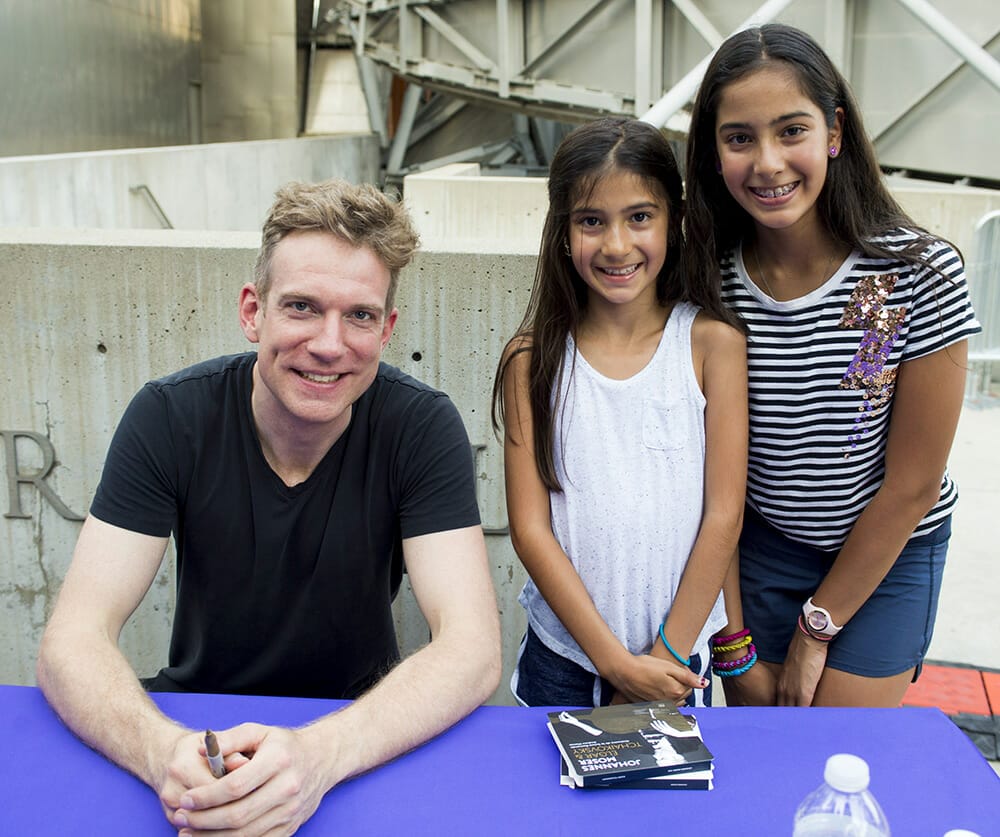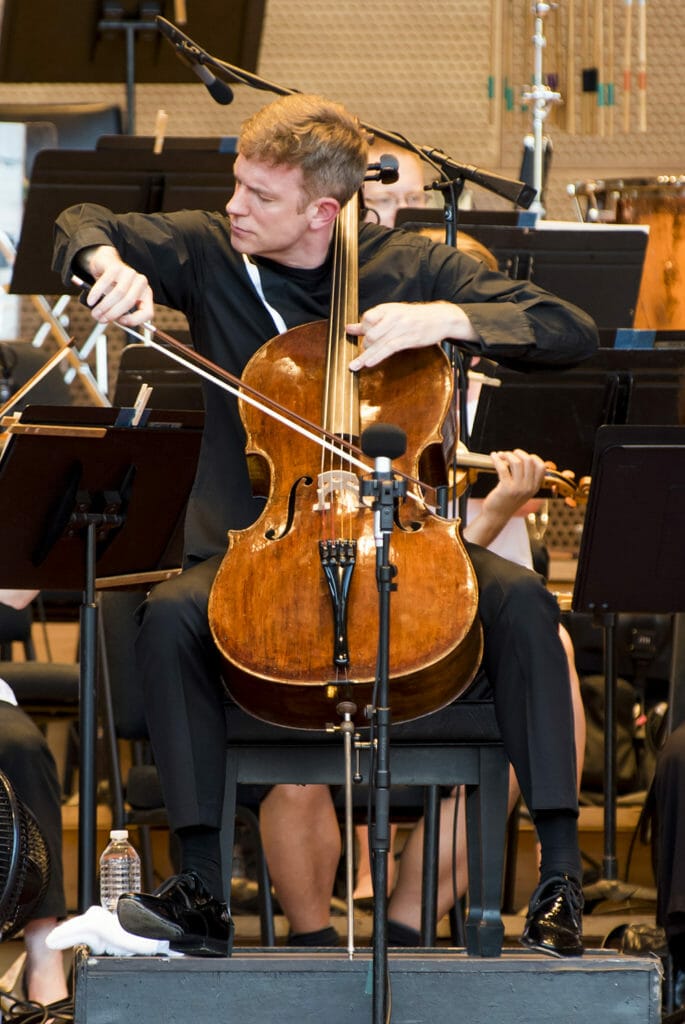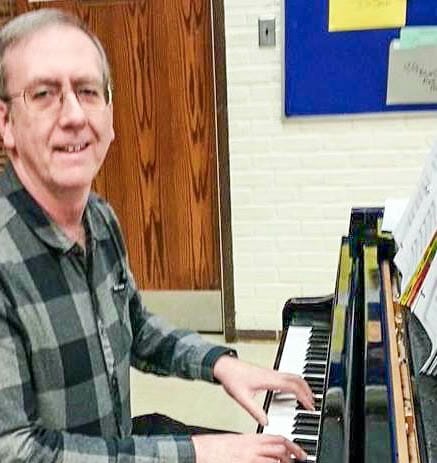Grant Park Music Festival Features Johannes Moser, cello
On a really hot muggy night in June, it was still a thrill to see and hear world class Romantic music playing outdoors. How hot was it, you ask? It was SO hot that musicians’ union rules made the conductor cancel one of the three pieces, ironically named Summer Evening, because it was too summery.
Heartfelt folk songs
Oh well, that left two great folksong specialists, both from what is now the Czech Republic to balance each other out, Antonin Dvorak and Leos Janacek. Dvorak wrote his cello Concerto and his New World symphony while living in New York from 1892 to 1895. As can happen when one is away from home for an extended period of time, both exhilaration and homesickness can set in. In Dvorak‘s case he turned to his beloved folk songs he would only hear in his homeland, and not in the New World where he found himself. The wonderfully exhilarating music he wrote around those folk tunes was perhaps designed to help him feel better.
Expressive instrument expresses disappointed love
The cello concerto he wrote is in B minor—a dramatic key, good at expressing heartfelt emotions—is especially so in the hands of Johannes Moser. Mr. Moser, a German Canadian, plays all over the world on a 1694 Guarneri cello, and does he ever play! Moser many times wrung about all the music and sound you could get out of an amazing instrument such as this Guarneri cello. Rocking back-and-forth, passionate, he was often collaborating as a special member of the orchestra, other times coming out of the fabric in short duets with a woodwind, or playing duets with the first violinist.
In the interview with Mr. Moser in the pre-concert conversation he said a theme of the second movement of the concerto was the favorite folk song of Dvorak‘s lady love, presumably back home in Czechoslovakia. Sadly for Dvorak, she did not return his love. What you hear in the music reflects this by a number of too short sweet duets between the cello and a woodwind player, and then between the cello and the concertmaster/first violinist. But one of the orchestral players always quits before the phrase reaches its culmination, and the sweet duet turns into a thoughtful, soulful solo by the cello—wonderful for music making but sad for the lonely lover.
But, thank God for the fresh, new forthright, optimistic theme of the last movement introduced by the cello. In musical terms called a Rondo, this is the form where the first theme -A- keeps coming back with interspersed contrasting material [ABACADA]. The victorious A theme wins in the end with a full orchestra reprisal full of drama and then a suddenly fast, satisfying end.
A Czech Fanfare for the Common Man
Leos Janacek (1854-1928) was commissioned in 1925 to write Czech patriotic, heroic music fanfares for a patriotic society called Sokol having a festival to be held in Prague the following summer. Having just heard an outdoor band concert playing fanfares, he was inspired to write his Sinfonietta—a shorter than usual symphony—for symphony orchestra with expanded numbers of brass band players added.
The Grant Park Music Festival playing outdoors is a good venue for such a piece, which is probably best played ONLY outdoors, with all the extra brass players. This reviewer has seen it with an even more expanded orchestra, but tonight there were six trumpets, five heroic horns, three trombones and tuba, two bassoons, plus extra clarinets, oboes, flutes and saxophone, and prominent piccolo playing with all the usual strings.
The heroic fanfare that is played by the French horns sets the mood for lifting up of the common man regardless of difficulties that come. Freshly victorious after World War I, Czechoslovakia was in the mood to celebrate. Each of the five movements of the Sinfonietta has a much different mood to portray after the fanfares: A castle, the Queens monastery, the street, and the Townhall, representing to Janecek certain beloved landmarks in Brno, his hometown.
For the final movement, that first noble fanfare by the heroic horns at the very beginning comes back, first seemingly at a distance and then closer and closer, louder and louder until the whole expanded orchestra is playing as loud as possible. This is beautiful, glorious music in extreme high range by strings and woodwinds balanced by all the brass players and percussion—not just by the horns this time. It’s a rare experience to hear this very unique, short symphony of Janecek’s. One could only wish for twice as many brass players.
This particular program will not be repeated but the Grant Park Symphony continues to play through August 18 this summer Wednesdays and Fridays at 6:30, and 7:30 Saturdays, mostly in Pritzker Pavilion at Millennium Park.
For more information check the Grant Park Music Festival website
Photos by Norman Timonera
About the Author:
Mark Lindeblad is a working pianist and bassoonist in Chicagoland. He received the Bachelor's of Music performance degree, bassoon major, piano minor from Wichita State University in 1978 and the Master's of Music performance degree in bassoon from Roosevelt University in 1983 in Chicago. While doing piano accompanying was always happening on the side from high school and college years, it stepped up to be Mark’s primary occupation in the 1990's. Today he is a piano accompanist at Glenbard South High School, and plays principal bassoon in the Southwest Symphony, and also finds time for about 20 private students studying either bassoon or piano. For more information, visit Mark Lindeblad’s website: www.markspianostudio.com






